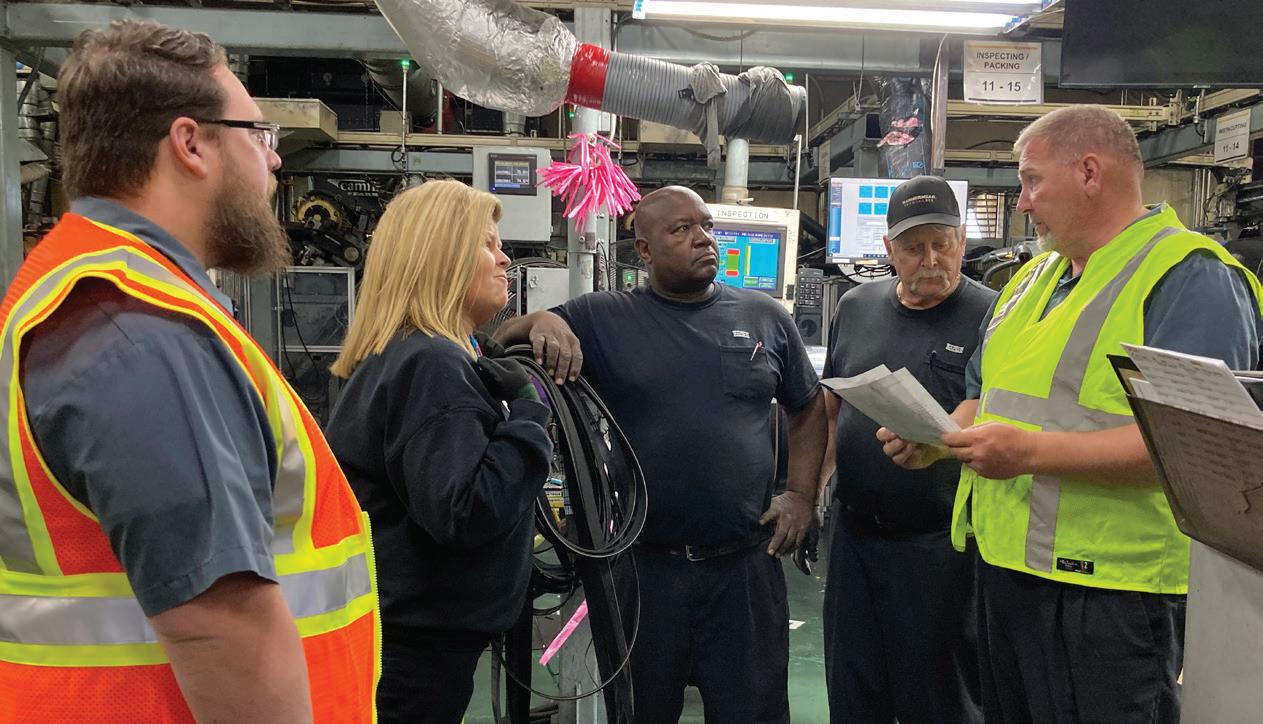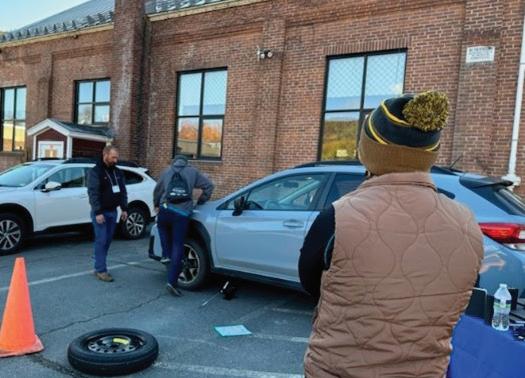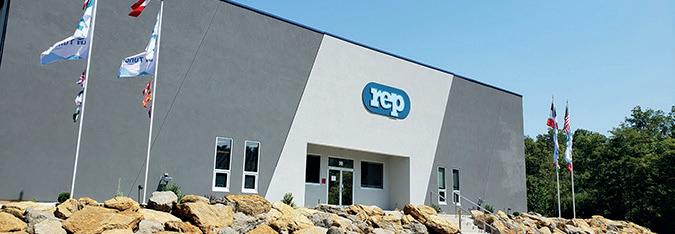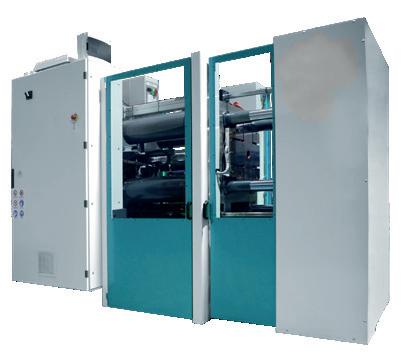
10 minute read
HR Professionals on the Front Lines of Recruiting and Retention: Part 1
By Lindsey Munson, editor, Inside Rubber
The rubber industry over the past four years has settled into its post-Covid-19 routines and protocols but, overall, it has remained a challenging time for human resources professionals who stand on the front line of recruiting and retaining the industry’s most valuable asset – its employees.
HR professionals are the first to connect with a potential employee who walks through the front door. They conduct and implement the onboarding process, set the tone for the company brand, trends and culture, build a sustainable workforce, and positively and proactively enforce a peoplecentered workplace – from management to the entry-level worker on the shop floor.
What was once known by HR professionals slowly is becoming a thing of the past. Loosening up on fixed job titles and specific job descriptions now has turned into a goal of not hiring just to fill the position, instead, it’s about creating employee balance, protecting customer needs and fighting for the future of the industry – all of which affect the bottom line. HR is leaning into a creative mix of old-school ways with new market trends when it comes to recruiting and retaining – from yard signs, partnering with the community and referral programs, to employee cross-training in job roles, flexible scheduling and bonus incentives.
HR Professionals Share Insights, Experiences and Resources
The five HR professionals interviewed for this article have two things in common – to be front-line workers that inspire within their communities and company, and to innovatively build a strong employee base. All of them believe that if an employee has a reason and a “why” to perform the job every day, then nine times out of 10, the company retains its talent and skilled workers not for just a job to perform but for a career.
From the shadows of the back office to the front line, these HR professionals are sharing approaches and insights to attracting the attention of new employees, ways to handle onboarding and incentives, combating attendance woes, encouraging safety and, lastly, building a company culture that sticks.
From La Habra, California, VIP Rubber & Plastic Company has been manufacturing custom rubber extrusions, plastic extrusions, rubber sheet products, molded rubber products, plastic pipe and tubing in the US since 1961. Albert Levalle, VIP Rubber’s human resources manager, leads the company in its “old school” ways of recruiting and retaining employees with a company culture based on hard work, safety and respect. Levalle won’t be found at his desk but rather walking the plant facility, engraining himself in the action and connecting with employees. “I want to be on the floor where the action is at, always available to employees, accessible and within reach, my door is open,” he said.
Daniel Gifford, human resources manager for Bando USA, Inc., Bowling Green, Kentucky, and Sandy Burnett, human resources generalist and seasoned employee of more than 25 years, are proactively and methodically working to recruit and onboard quickly while strategically working closely with the 125 employees that are in it for the long haul. Gifford and Burnett do most of their hard days’ work from what they call “the heart of the facility” – their office, which resides right by the break room that has an influx of employees coming and going every day. Bando’s facility has been in operation for over 35 years and is a supplier of automotive and industrial power transmission and conveyor belts.
Garware Fulflex USA, Inc. (Fulflex), Brattleboro, Vermont, is a manufacturer of rubber sheets and elastic tapes, positioned in a small town along the Connecticut River where Anne Meyer, human resources manager, and her team of one, Pamela Savory, HR administrator, passionately work tackling labor market trends and setting aside time, no matter the hour, to give employees their full attention. Meyer spoke keenly about the labor struggles not just for Fulflex, but also for the community.
“We’re the only rubber manufacturer in the area. Not just our company but all businesses are struggling to hire and retain employees,” she said. “Between the companies in Brattleboro, we have a rotationalemployee base where one leaves us and goes to another company. It’s hard. But there are positive times when an employee leaves and we get to do an exit interview and understand it was not about Fulflex, but more about that employee being closer to family or just needing to make a living situation easier. There are times I get to guide employees to other companies of interest to get them where they need to be. The job can be challenging, although can be rewarding.”
Fernando Gauna is a human resource recruitment specialist at R.E. Darling Co., Inc. (REDAR), a composite manufacturing company in Tucson, Arizona, that prides itself on its employees and their dedication to producing quality products “because someone’s life depends on it.” Gauna said employees’ dedication is important to daily operations, so people who are recruited and hired are a critical piece to creating a company based on “quality over quantity.” Gauna said, “It’s important to REDAR to have data but also a culture that allows for sound decision-making when it comes to employees and the future of their employment. We benchmark ourselves with top-performing companies and want to be competitive in this tight labor market.”
Residing in Elgin, Illinois, Ebco, Inc., is a family-owned and engineered-driven company supplying OEM customers with elastomer solutions since 1951. Bill Bernardo, CEO, knows Ebco is a large company with a lot to offer new hires and current employees, and he believes in operating with flexibility and close communication. He said, “We try to maintain a small business atmosphere. We want employees to share the good and the bad, and we want those in the C-suite as well as myself to be available to listen.”
Recruiting Strategies and Employer Branding
As a company, attracting candidates that fit the brand right from the start is crucial to getting them through the onboarding process and retaining them for years to come.
Meyer is versed in just how important company branding is. “The history is interesting,” she said. “Fulflex is owned by the parent company in India and is a woman-owned business. When I attend job fairs, I share the history and story of Fulflex with job seekers and post a stand-up sign that features our owner in an article on women in the tire and rubber business. It’s interesting because when this is mentioned to candidates, they say in question, ‘It’s a woman-owned business?’ It piques interest and gets the conversation flowing, a valueadded benefit for our company when recruiting.”
Meyer also pushes company-wide employee engagement in the community. She said it’s a win-win for creating company awareness and being visible to possible candidates, but also gives employees value outside of the facility and allows managers and teams to bond.
“Last August, we sponsored the 200 Backpack Challenge partnering with Brattleboro Auto Mall. It was a massive event with the community. The backpacks were filled with various school supplies and handed out to kids in the community who could not afford to buy supplies for back-to-school. Kids could also get a free haircut at the event. It was an outstanding public event with the Auto Mall, the community and our company,” she said “In addition, this past fall, Fulflex donated money to a food drive where every seat at the theater in downtown Battleboro housed a bag full of food. These community events are big for Fulflex!”
With the population thinning in Battleboro, Meyer looks to the surrounding states of New Hampshire and Massachusetts for a recruitment base, focusing on the gap between high school graduates and seasoned employees. She said, “Right now, I’m targeting high school graduates and believe they’ll be the segment that will fill the entry-level machine operator positions. We’ll be partnering with the Brattleboro Development Corporation, which has the Pipelines and Pathways Program as they closely work with the high schools Windham County, Vermont.”

Through that partnership, Meyer will attend fairs in May and June and will step into several high schools to tap local talent and spread Fulflex’s story. As part of Meyer’s efforts, there has been a significant return for the company in finding graduate hires through an event on life skills held in the village of Townshend, Vermont, where students are hands-on learning and adapting to life scenarios, from changing a car tire to budgeting for car insurance – all of which shows that a career and being financially responsible are necessities in life. Meyer said, “Then we get to share the job opportunities right in their backyard, such as an entry-level position with Fulflex.”
REDAR saw an opening and decided to make a few minor adjustments to its new hire policy. “We increased our referral bonuses and changed our policy to allow immediate family members to work here,” Gauna said. “Our data shows us that the referral bonuses and hiring immediate family members has increased retention, and productivity also has increased.”
Gifford shared similar thoughts, “Bando saw the light when it came to the referral program including referrals from family, friends, relatives and current seasoned employees – we saw a difference in work performance, attendance and culture. But it doesn’t stop with referrals, Bando will continue working closely with the Chamber of Commerce in Bowling Green.”
Ebco, being a family-owned company, knows firsthand how important recruiting from local and state talent is to get depth across the company’s platform. Bernando said, “For new hires, we are very active in going to college recruiting events and when seeking a position that requires experience past an entry-level position, we sell our culture and benefits. Those two things must be buttoned up and sound to attract top-skilled talent.”
For years VIP Rubber has been recruiting through temp agencies, hiring walk-in candidates, placing ads in the local newspaper, posting signs in the front of the building and looking deep into its community for talent – methods that are still working well for the company. Levalle said, “We’re old school from newspaper ads to yard signs. We’ve had so many people coming in the front door, averaging three people a day, along with phone calls inquiring about job opportunities. And for us, it’s also financially better because, at this point, the temp agencies are a thing of the past. It’s all working.”
Similar to REDAR’s focus on a referral program, Bando relies heavily on its current employees to refer friends and relatives. For example, a tenured employee recruits his son to work for the company – it is with a high percentage that this referral sticks vs. a temp employee. Gifford said, “We’ve had a ton of success with the referral bonus program.”
On the flip side, even though temp employees aren’t where Bando would like to spend its time or investment currently is housing 12-15 company temps who have an opportunity to grow into a production position. Gifford said, “Bando has an amazing tenure of 20-30 years to retirement with several of its employees. At some point, we’re going to start feeling the effects of a lot of people retiring and we’re trying to build up that middle band of people with experience who could eventually become the future managers.” It’s the middle-aged employment gap that Bando would like to fill immediately. And, to fill the gap, Bando works closely with Bowling Green’s Chamber of Commerce.
Bando’s recruitment strategy is based on two approaches:
● Fill entry-level temp positions – These positions do not take a lot of training; the job role and responsibilities are easy to learn, and temp employees can step into the job quickly. The goal for the temp employee when the job hours expire is to move into a direct/full-time position.
● Fill direct, full-time positions – These positions are for employees directly hired for a production or general role, where they are onboarded, trained and released within a month to do the job on their own. These positions could earn incentive bonuses, attendance awards and safety certificates.
“Bando recently had an employee who referred three of his friends, and they all work for the company in full-time indirect positions. The employee referral bonus program has been our best source of candidates over the past six months,” Gifford said.
Focusing on Benefits
It is important not to undervalue the need for a benefits package for full-time and part-time employees. A wellrounded benefits package including healthcare, wellness, dental, vision, life insurance, disability and retirement drives employee behavior the moment an employee is recruited and continues to be a driver through the years. Benefits make up about 30% of an employee’s compensation according to the U.S. Bureau of Labor Statistics. It is the benefits package that gives employees a work-life balance.
Lavelle said a full benefits package is essential in recruiting. He continued that benefits heavily weigh on a candidate’s decision to accept an offer from a company or to leave. “We give a full benefits package with insurance, vision, dental and life insurance,” he said. “VIP pays out the majority of it. We used to pay 100% but noticed that when you pay 100% employees don’t have a stake in their job and the company. So, in turn, we decided that it was important to add immediate value to the position an employee is being hired for and requested a small buy-in to the benefits package. If the employee buys in, they will use the benefits appropriately and feel valued in the process. We invest in the employee; the employee invests in us.”

Ebco is competitive among other manufacturing companies in Illinois when it comes to its wage rates and benefits package. Bernardo shared, “We pay at or above published pay rates, with the opportunity for employees to earn bonuses through their 90-day reviews.”

REDAR is staying ahead of the curve by conducting compensation analysis against other manufacturing companies in Arizona, helping to stay competitive in pay and benefits for all positions. “We have increased our starting pay to $16-$17 per hour,” said Gauna, “and the minimum wage for Arizona is $13.85. We benchmark ourselves with top-performing companies and want to be successful in this tight labor market.”


As for Illinois-based, Bando, Gifford said, “We try to get new hires in the door quickly, streamline several items such as background checks and drug screenings and I believe that’s helped us keep from losing a few people. We get new employees trained and, in their roles, allowing them to start feeling valued and earning a wage along with benefits.” For Bando, it takes an estimated one month to get a new hire fully in the door and trained to do the job on their own.
Recruitment is key for human resources because finding and acquiring talent is essential in meeting company goals and succeeding as an organization. By building a recruitment strategy and a competitive benefits package, companies can ensure a workforce that improves company culture, adapts to changing environments, reduces turnover and positively hits the bottom line. Together, the rubber industry will continue to make improvements and find solutions to the volatile labor market. “It’s how you treat people from the moment you meet them. It’s a simple recruiting strategy – a smile and a conversation can give a person the extra push to where they are meant to be,” Meyer said. n










